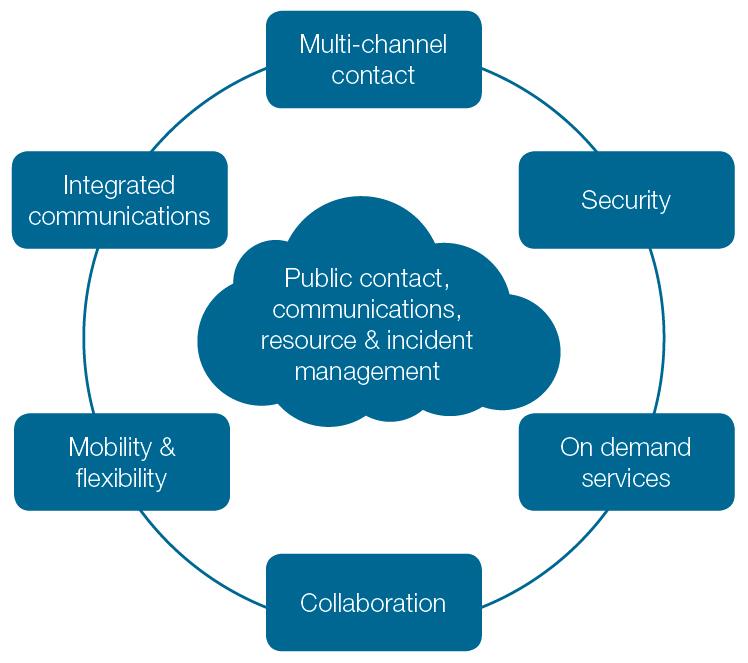May 2017 saw the WannaCry ransomware attack affect more than 250,000 computers in over 150 countries in both private and public sector organisations. While patches had been released for supported operating systems as early as March, many had not been deployed and systems running unsupported versions remained vulnerable to the attack. The public sector was a particular concern given system vulnerability and loss of service has a direct correlation with citizen vulnerability.
Most of the systems across the public sector are deemed mission-critical to either the individual agency or as part of the country’s Critical National Infrastructure and £multi-million contracts are in place to protect these systems, the majority of which remain individual on-premise deployments.
To date, organisations’ efforts to move systems into the cloud have been tentative, particularly in the case of public safety contact systems, with many concerns continuing over cost, access and security. With costs dropping and identity & access management controls in place security should no longer be seen as a reason not to embrace change.
Delivering the front line from the cloud
Is it time to move the front line of emergency service response into the cloud?
Undoubtedly the latest generation of solutions are ready and, whether from a single supplier or a consortium, the benefits now far outweigh the concerns and can be loosely categorised into six primary functions.
Security
- Guaranteed service levels and availability
- Always up to date
- Identity and access management controls
- Disaster recovery and backup services
Multi-channel contact
- Ability to integrated a vast range of public facing communication channels
- Enabling self-service
- Efficient, low cost channel shift away from call handling
- Automation through the use of ‘chatbots’ and other AI technology
Integrated communications
- Delivering telephony, TETRA, LTE and other services direct to the user
- Streaming media to and from in-field devices
Mobility & flexibility
- Access from any device, anywhere supported by a role-based security model
- Location-based services for resource management
- and deployment
Collaboration
- Sharing services and resources across the response agencies
- Delivery of multi-agency intra- and inter-service collaborative solutions
On demand services
- Access to operational scale to cater for peak demand
- Access to infrequent or specialist services such as analytics
Of course, migration to the cloud doesn’t need to be a ‘big bang’ impact on the organisation. Whilst the latest platforms are developed and tested in cloud environments many deployments are still on-premise.
The first step may be to use a cloud-based version for testing and training, allowing easy access rather than having to abstract users from their normal working environment, and minimising additional costs together with any disruption to their business as usual activities. The next logical step would be to use the flexibility and scale of the cloud for disaster resilience; reducing or removing the cost of buildings, licences and hardware for a service that is infrequently employed.
From there, particular services such as telephony or ‘radio’, could be provisioned from hosted systems, these could then be shared across multiple organisations and, eventually, fully hosted, collaborative, multi-agency contact and dispatch solutions could be developed to truly transform the way public services are delivered.

The future of public safety service delivery
Managing the demand for services effectively is the key to ensuring operational capacity in these times of change. Effective demand management needs more than just convergence of allied technologies and interfaces between existing systems. It requires a much richer and deeper level of integration coupled with intelligent solutions both within the service and from a public-facing perspective. When managed at this level a service will be able:
- To effectively manage all outcomes
- To quickly and accurately identify repeat contact
- To accurately assess threat, harm and risk
- To make better use of resources – right people, right skills, right information, right place, right time
- To maximise officer and public safety
- To use local knowledge to get to know repeat victims and offenders
- To work effectively with partners and the public
Harnessing new digital technology to allow the public to access services without necessarily making a voice call is an imperative. Self-service smartphone apps, portals and the use of the latest ChatBot technologies can help the public access many services directly.
This technology can capture a level of data that can be used to analyse the requirements and, where appropriate, forward the request to other partners or on to an operator for further action.
It can also provide a level of real-time situational awareness to help inform a proportionate response.
Employing innovation and new technologies will help transform service delivery but the greatest driver will be organisational collaboration and rationalisation. As operational collaboration increases and, in some countries, legislation is passed to support deeper transformation there will be a move from shared technology and systems to shared contact centres and ultimately, single contact, dispatch and management centres for agencies delivering all emergency and non-emergency response in a city, region or country.

Many elements of public safety systems can be encompassed by cloud solutions

Delivering innovation and leading change
Whilst on the front line there has always been a will to work collaboratively, the challenge that has always faced the delivery of public services is that current IT systems, infrastructure and organisation has resulted in separate silos that have significantly limited the scope for real collaboration. This has resulted in fragmented service delivery and a fragmented view of citizen engagement across communities.
The move to cloud eliminates those barriers. Platforms and solutions to support this future transformation must continue to innovate but importantly, implement change at a pace that meets the needs of the organisation. Unified solutions from trusted partners with proven track records of investment and delivery will be technically more stable, robust and resilient than complex systems built from a range of different suppliers with interfaces between them.
As with the launch of ControlWorks in 2013, Capita’s strategy is to continually innovate and embrace technology so that we continue to deliver step changes in capability, in this case supporting true operational collaboration across all public safety agencies.
In the future, the most effective public services will be those that drive convergence to levels that provide a citizen- and place-centric common operational view, recognisingthat demand across all public safety agencies has become more varied and complex, all dealing with vulnerability and the effective management of risk.
Cloud is the key!
Contact details
Matthew Palmer
Product Strategy and Propositions Director
Capita Secure Solutions & Services
Matthew.palmer@capita.co.uk




